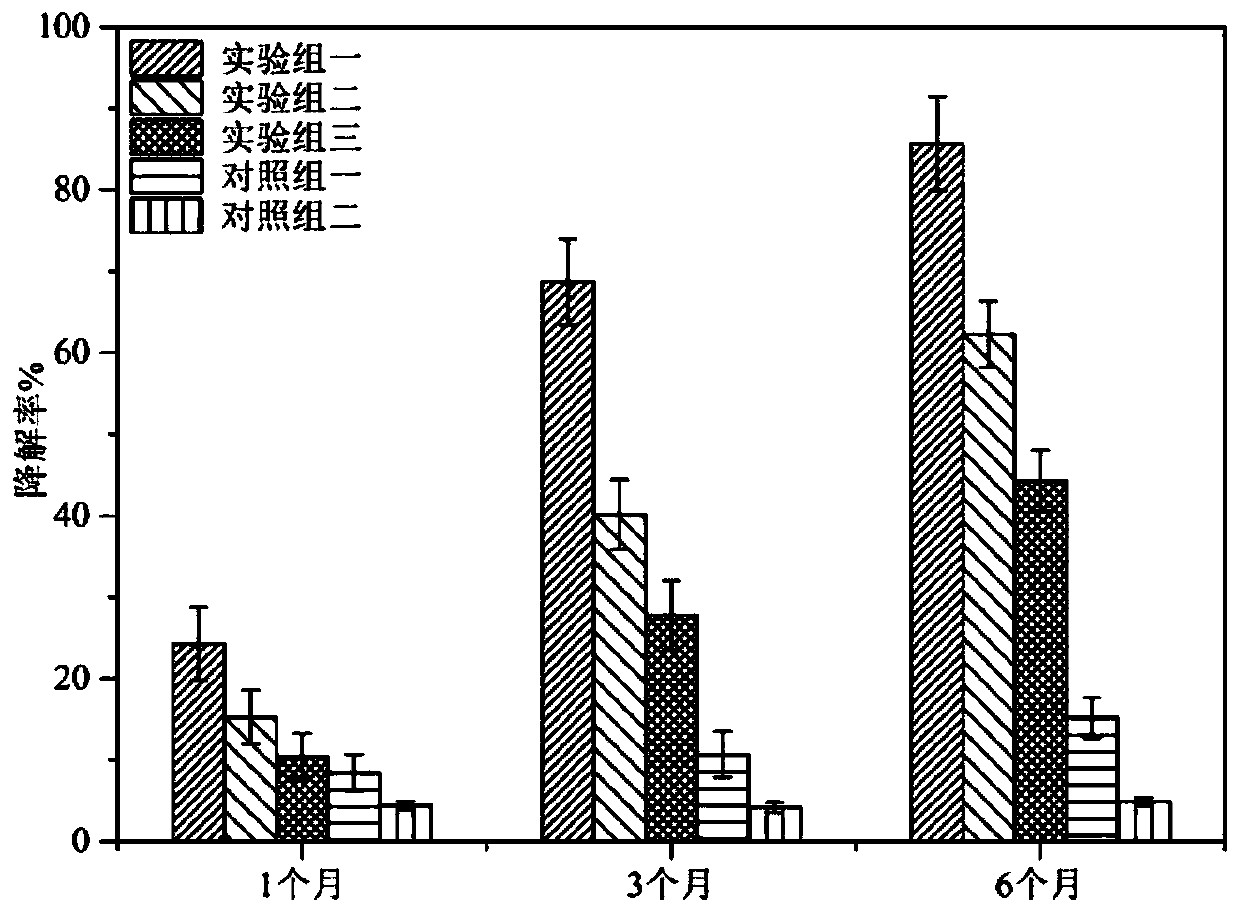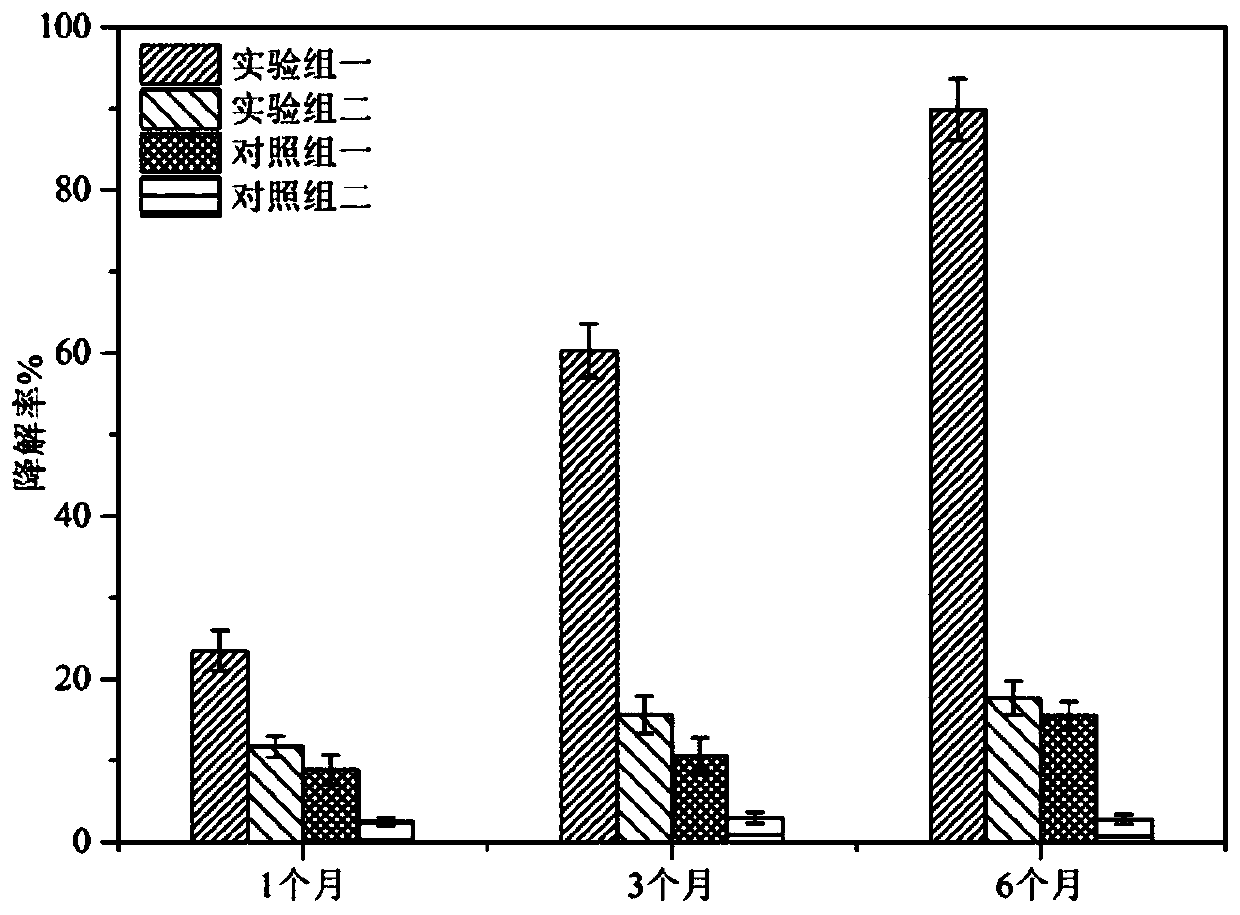Method for repairing oil-contaminated soil through reinforcement of biochar-base complex microbial inoculant
A compound bacterial agent, oil pollution technology, applied in the restoration of polluted soil and other directions, can solve the problems of slow growth of oil-degrading microorganisms, reduced survival rate, resource consumption, etc., and achieves easy control of process parameters, guaranteed degradation efficiency, and degradation quality. Guaranteed effect
- Summary
- Abstract
- Description
- Claims
- Application Information
AI Technical Summary
Problems solved by technology
Method used
Image
Examples
preparation example Construction
[0033] (1) Preparation of biochar-based composite bacterial agent: using biochar as a carrier, mycobacterium CSC-6 bacterial liquid was prepared by adsorption method; the preservation number of mycobacterium CSC-6 is CCTCC No: M 2017726, a typical culture in China Preserved by the preservation center, the preservation date is November 27, 2017; biochar can be one or a mixture of rice husks, cotton stalks, japonica rice or rattan.
[0034] (2) Preparation of biosurfactant: with mannitol as carbon source, Pseudomonas aeruginosa W-3 is fermented and cultivated to obtain a fermentation broth containing biosurfactant, which is rhamnolipid ; The preservation number of Pseudomonas aeruginosa W-3 is CCTCC NO:M2010048, which was preserved in China Center for Type Culture Collection, and the preservation date was March 05, 2010.
[0035] (3) Conservation of polluted soil: the polluted soil is crushed, and the polluted soil is sieved with a fineness greater than 10 mesh sampling sieves, ...
Embodiment 1
[0041] In this embodiment, the method of strengthening and repairing oil-contaminated soil with a biochar-based composite bacterial agent is used to treat fresh oil-contaminated soil. The test method is as follows:
[0042] (1) Collect unpolluted fresh soil, pass through a 10-mesh sieve after crushing, add petroleum to make the oil content be 30000mg / kg, and obtain the fresh petroleum-contaminated soil that the oil content is 30000mg / kg;
[0043] (2) Using biochar as a carrier, prepare mycobacterium CSC-6 bacterium liquid by adsorption method, wherein the mass fraction of mycobacterium CSC-6 is 1%, and biochar is selected from rice husk charcoal; with mannitol as carbon source, the Pseudomonas aeruginosa W-3 is fermented and cultured to obtain a fermentation liquid containing a biosurfactant, and diluted with water to obtain a dilution of a fermentation liquid containing a biosurfactant, wherein the biosurfactant is rhamnolipid, and fermented with a biosurfactant The mass frac...
Embodiment 2
[0048] In this embodiment, the method of strengthening and repairing oil-contaminated soil with a biochar-based composite bacterial agent is used to treat fresh oil-contaminated soil. The test method is as follows:
[0049] (1) Collect unpolluted fresh soil, pass through a 10-mesh sieve after crushing, add petroleum to make the oil content be 50000mg / kg, and obtain the fresh petroleum-contaminated soil that the oil content is 50000mg / kg;
[0050] (2) Using biochar as a carrier, prepare mycobacterium CSC-6 bacterium liquid by adsorption method, wherein the mass fraction of mycobacterium CSC-6 is 1%, and biochar is selected from rice husk charcoal; with mannitol as carbon source, the Pseudomonas aeruginosa W-3 is fermented and cultured to obtain a fermentation liquid containing a biosurfactant, and diluted with water to obtain a dilution of a fermentation liquid containing a biosurfactant, wherein the biosurfactant is rhamnolipid, and fermented with a biosurfactant The mass frac...
PUM
 Login to View More
Login to View More Abstract
Description
Claims
Application Information
 Login to View More
Login to View More - R&D
- Intellectual Property
- Life Sciences
- Materials
- Tech Scout
- Unparalleled Data Quality
- Higher Quality Content
- 60% Fewer Hallucinations
Browse by: Latest US Patents, China's latest patents, Technical Efficacy Thesaurus, Application Domain, Technology Topic, Popular Technical Reports.
© 2025 PatSnap. All rights reserved.Legal|Privacy policy|Modern Slavery Act Transparency Statement|Sitemap|About US| Contact US: help@patsnap.com



